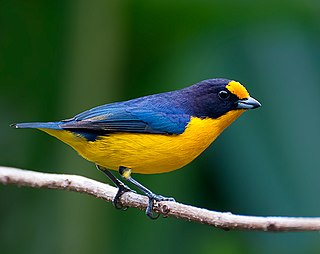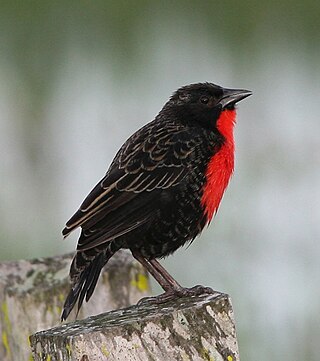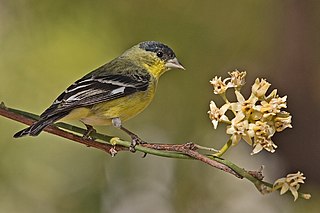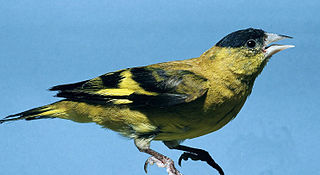
The Eurasian siskin is a small passerine bird in the finch family Fringillidae. It is also called the European siskin, common siskin or just siskin. Other (archaic) names include black-headed goldfinch, barley bird and aberdevine. It is very common throughout Europe and Eurosiberia. It is found in forested areas, both coniferous and mixed woodland where it feeds on seeds of all kinds, especially of alder and conifers.

The pine siskin is a North American bird in the finch family. It is a migratory bird with an extremely sporadic winter range.

The violaceous euphonia is a small passerine bird in the true finch family. It is a resident breeder from Trinidad, Tobago and eastern Venezuela south to Paraguay and northeastern Argentina. The bird's range in northern Brazil is the lower portion of the Amazon Basin and the adjacent Tocantins River drainage, with its northwestern limits from Brazil and the Guyanas, the eastern banks of the Orinoco River drainage in central Venezuela.

The red-breasted meadowlark is a passerine bird in the New World family Icteridae. It was formerly named red-breasted blackbird but is not closely related to the red-winged blackbird group.

The grassland yellow finch is a small passerine bird. Despite its name, it is not a finch, but is a seedeater. These were formerly united with the buntings and American sparrows in the Emberizidae, but are now known to be tanagers.

The lesser goldfinch is a very small songbird of the Americas. Together with its relatives the American goldfinch and Lawrence's goldfinch, it forms the New World goldfinch clade in the genus Spinus.

The yellow-bellied siskin is a small passerine bird in the finch family Fringillidae. It breeds from Costa Rica south to southern Ecuador, central Bolivia and the highlands of northwestern Venezuela.

The hooded siskin is a small passerine bird in the finch family (Fringillidae), native to South America. It belongs to the putative clade of neotropical siskins in the genus Spinus sensu lato.

The star finch is a seed-eating bird species found in northern Australia. It has a distinctive red face and bill, and broad white spots down its flanks. One of its three subspecies may be extinct.

The Fiji parrotfinch is a species of estrildid finch endemic to Fiji that was formerly considered to be a subspecies of the red-headed parrotfinch. This parrotfinch is a small, mainly green bird with a red head and tail and a stubby dark grey bill. It is found in both forested and open habitats, and has adapted well to man-made environments such as grasslands, pasture and gardens. Pairs have a courtship display in which they fly above the trees in an undulating flight, calling constantly. Breeding birds build a domed grass nest with a side entrance, and lay a clutch normally of four white eggs. Newly hatched chicks are naked and pink, with blue balls at the upper and lower corners of the gape, and black markings inside the mouth; older fledglings resemble the adults, but lack the red head colouring. The Fiji parrotfinch eats seeds, especially of grasses, and also readily feeds on insects and nectar. It forms small flocks of up to six birds after the breeding season.

The tricoloured munia is an estrildid finch, native to Bangladesh, India, Sri Lanka, Pakistan, and southern China. The species has also been introduced to the Caribbean, in Trinidad, Jamaica, Hispaniola, Puerto Rico, Cuba, and Venezuela. This species, like the chestnut munia has been known as the black-headed munia. Immature birds have pale brown upperparts, lack the dark head found in adults, and have uniform buff underparts that can be confused with immatures of other munias such as the scaly-breasted munia.

The Cape siskin is a small passerine bird in the finch family. It is an endemic resident breeder in the southern Cape Province of South Africa.

The Drakensberg siskin is a small passerine bird in the finch family. It is an endemic resident breeder in the eastern Cape Province Transkei and western Natal in South Africa, and in Lesotho.

The black siskin is a species of finch in the family Fringillidae. It is found in Argentina, Bolivia, Chile, and Peru. Its natural habitats are subtropical or tropical high-altitude shrubland and subtropical or tropical high-altitude grassland.

The thick-billed siskin is a species of finch in the family Fringillidae. Found in Argentina, Bolivia, Chile, and Peru, its natural habitats are subtropical or tropical moist montane forests and subtropical or tropical high-altitude shrubland.

The olivaceous siskin is a species of finch in the family Fringillidae. It is found in Bolivia, Ecuador, and Peru, where its natural habitats are subtropical or tropical moist montane forests and heavily degraded former forest.

The Andean siskin is a species of finch in the family Fringillidae. It is found in Colombia, Ecuador, and Venezuela. Its natural habitats are subtropical or tropical moist montane forests, subtropical or tropical high-altitude shrubland, subtropical or tropical high-altitude grassland, and heavily degraded former forest.

The yellow-faced siskin is a species of finch in the family Fringillidae. It is found in Brazil and Venezuela.

The Tibetan serin or Tibetan siskin is a true finch species.

The Trinidad euphonia is a species of bird in the family Fringillidae. It is common in northern Colombia and northern Venezuela and uncommon to rare on the Caribbean island of Trinidad. Like all euphonias, it is small, stocky, and short-tailed; unlike some, it is sexually dimorphic. The male is glossy blue-black on the head, back, throat, and upper breast, with a bright yellow forehead and crown, and bright yellow underparts. The female is olive-green above and yellow-olive below, with a grayer patch running down the center of her breast and abdomen, and bright yellow undertail coverts. Its calls are high-pitched, plaintive whistles: the two most common are a single-pitched, double-noted "pee pee" or "tee dee", or a rising, double-noted "puwee", "cooleee" or "duu dee". Its song is a short, jumbled mix of musical and nonmusical notes.






















